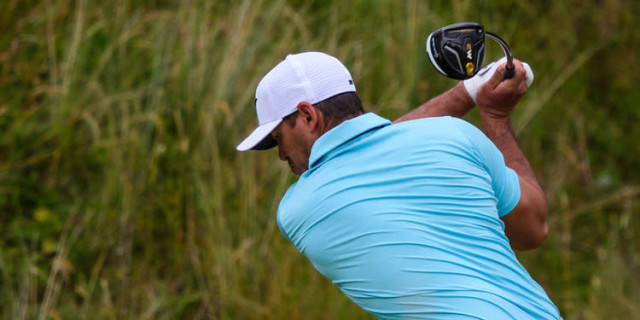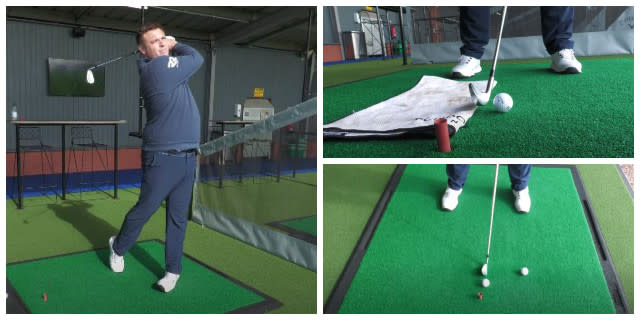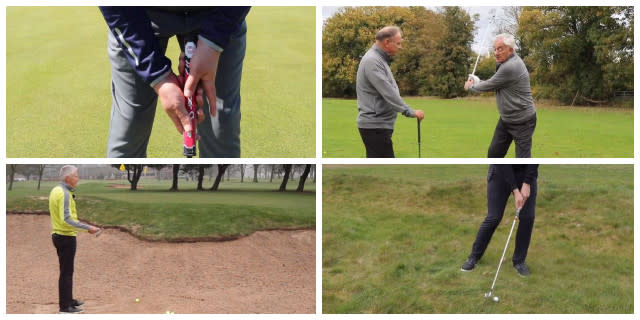What You Can Learn From Brooks Koepka's Workouts
Article by Nick Buchan - Golf Fit.co.uk/training
Back in 2013, Brooks Koepka wasn’t the latest phenom in waiting on the PGA Tour. In fact, he was plying his trade over on the Challenge Tour, progressing through the rankings largely unnoticed.
Fast forward to now and the era of Brooks is well and truly here. He is now a four-time major champion, as I'm sure you know!
A large part of helping Brooks achieve these impressive results was his physical transformation:
It’s pretty clear, just from looking at the transformation, this involved some serious training. If your idea of fitness for golf is time spent on a treadmill, balancing on a Bosu ball or mimicking the swing with a cable, then you have a lot to learn in the era of Brooks!
That said, it should also be pretty obvious the Brooks of nowadays is a beast; and a full time athlete to boot, and as such his workouts probably aren’t going to be suitable for you, the reader with a 9-5 job and perhaps an inconsistent relationship with both the treadmill and the barbell.
In this article, I will breakdown the concepts behind Brooks’ training and help you implement those ideas into your training in a way that is appropriate to your own physical fitness and capability level.
Lesson #1 - Get Strong to Add Yards
A quick scroll of Brooks' Instagram will reveal lots of heavy lifting. And as you can see Brooks is a pretty strong dude!
Strength is an important physical attribute for golf as, whilst it may not be a direct determinant of clubhead speed and performance itself, it underpins the specific capabilities we need to perform on the course.
As the quote from legendary strength coach Mark Rippetoe suggests: “Strength is the most general physical adaptation. Improve strength and, to some extent at least, every other physical quality will increase”.
When we consider golf performance our chief aim in the gym is probably to increase the distance we hit the ball.
The physics of accelerating a golf club, and ultimately the golf ball, as fast as possible is pretty simple:
Force X Mass = Acceleration
Your maximal strength is how much force you can produce. Of course, the golf swing is also a relatively quick movement, so power (which is force divided by time) and rate of force development (how quickly you can produce force) is also vital. However, your ability to produce force full stop must be developed first.
As another legendary strength coach, Mike Boyle says, "strength is the road to speed and power”.
I like to use the analogy of a sports car here. If you have a smaller engine than the other cars in the race you won’t be able to go as fast. Sure, you can improve the handling and acceleration of the car (this is the equivalent of improving the rate of force development and power) but ultimately if you want to win the race (hit the ball further) you need a bigger engine (to get stronger).
Lesson #2 - Don’t Be Afraid to Get Strong
There are largely two arguments used to justify the idea strength is bad for golf and strength training causes injury and reduces flexibility.
First, let’s look at the injury argument.
Brooks has been remarkably resilient to injury his entire career thus far, and whilst there are a whole host of factors that go into this and it would be churlish to claim his training regime is the reason, it is almost certainly a factor.
However, this is a case study of one, and just as I said in this article covering injury to golfers and the medias willingness to blame it on strength training, a case study of one does not constitute a body of evidence.
So let us take a brief look at the results of some of the peer-reviewed, randomised, controlled studies on the topic.
First off, studies have shown that over 80% of the injuries in golf are due to overuse. Secondly, a huge meta-study of over 26,000 participants demonstrated that strength training reduces the likelihood of injury by one third.
Rhetorical question time...
If 8 out 10 injuries, in the game you love to play, are caused by the same thing and I could sell you a magic pill that prevented one-third of those eight injuries happening, would you buy?
Thought so! Strength training is that magic pill - the only difference is you can have access to it for free if you like!
The second common misconception is that strength training will reduce the flexibility required to swing the golf club.
Do you see reduced flexibility here?

Additionally, the body of research here has in fact shown strength training to have no detrimental effect on flexibility. Further studies have even concluded strength training, used in combination with stretching, was more effective than stretching alone in improving flexibility.
Lesson #3 - Training Doesn’t Have to be ‘Golfish’ and Mimic the Golf Swing
The other thing you will hopefully have noticed from Brooks’ workouts is that very little of what he does is mimicking the golf swing.
This is another common misconception among both golfers and even golf fitness trainers. I recently read a book by strength coach Dan Clever that probably put it most concisely:
"It is very common for people to consider specific training to only be activities that look similar to the sport itself. Of course, such an activities may be a very valuable. However, this does not mean that other activities that less closely visually resemble the sporting skill itself might not be equally beneficial.”
To my mind this comes down to three errors in thinking:
Firstly, how much a exercise looks like the golf swing is just one factor in determining how specific to the goal task it is. The time constraints of the movement (the golf swing is relatively quick movement), the direction of force, type of muscular contraction, etc are all factors in determining how specific an exercise is.
Based on this you can start to see how an exercise might not necessarily look like the golf swing to be considered specific.
Secondly, an exercise doesn’t actually need to be that specific in terms of closeness to the movement pattern in order to transfer to performance.
Indeed, the latest research, conducted by Jack Wells out of the mighty UoB is confirming that the highest correlates to clubhead speed are in fact vertical jumps (specifically a non-countermovement squat jump and countermovement jump) and squat strength.
Thirdly, one of the most important concepts in fitness training is progressive overload. Progressive overload simply means doing more over time - increase the weight, sets, reps, amount of work done in a certain time, etc. It is important to consider that many exercises that might be classed as specific often are not progressively overloadable as there more general counterparts and therefore may not provide the same benefits or potential for long-term gains.
For my practical guide to golf-specific training that actually improves performance on the course check out the video seminar over on my Facebook page.
Lesson #4 - Prime Performance
Brooks caused quite a stir at the WGC in Memphis with his arrival on the course only 45 minutes before his tee time. And his comment after.
What Brooks knows is your performance on the course can be hugely improved by an adequate physical warm-up - and no, hitting balls is not what that means.
Indeed, a 5-10 minute dynamic warm-up has been shown to improve clubhead speed, ball speed, distance, accuracy, strike quality, smash factor, and swing path.
Brooks is potentially on the path towards golfing greatness and his physical transformation has undoubtedly been a major part of that rise.
Most importantly, what I have tried to demonstrate here is, whilst some people are born with certain physical advantages making them natural golf athletes, Brooks is not one of them!
He is a golf athlete that has been created through hard work. And you can do the same!
Whilst, you may not turn yourself into a physical specimen like Brooks and whilst his exact workouts might not be appropriate, you can still improve your physical skills, and your performance as a result, through the same hard work.
Applying the lessons outlined here will get you started along that road.
Alternatively, if you are looking to take a giant leap along that road and get a workout that really is appropriate to you as an individual - all my online programs are fully personalised based upon your individual assessment results.
Sign-up today, quoting the discount code ‘GolfshakeBonus’ to receive a 30minute consult call with one of our coaches and a copy of our highly sort after goal setting workbook free too.
Click here to starting training appropriately to your needs and goals, and to claim your freebies!
For more on Nick and Golf Fit, visit https://www.golffit.co.uk/training or follow Nick on Twitter.
Related Content: Tuition Tips Improve Fitness daily picks Brooks Koepka
Nick Buchan focuses solely on training golfers and with almost 10 years experience has worked with everyone from major championship players and tour pros to amateur golfers on almost every continent. Nick continues to be at the forefront of driving knowledge on golf fitness and regular contributes to TPI and other industry leading websites.
To find out more about Nick you can visit: @nick_golffit, Facebook: www.facebook.com/nickgolffit or via: www.golffit.co.uk






















